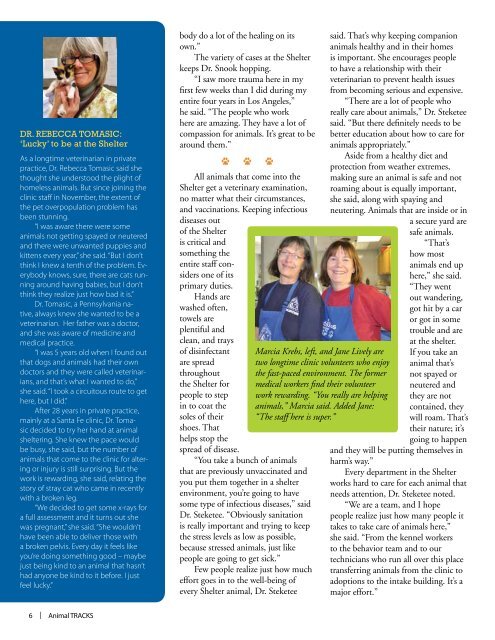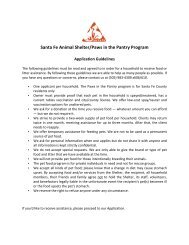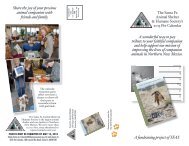HERE - the Santa Fe Animal Shelter and Humane Society
HERE - the Santa Fe Animal Shelter and Humane Society
HERE - the Santa Fe Animal Shelter and Humane Society
Create successful ePaper yourself
Turn your PDF publications into a flip-book with our unique Google optimized e-Paper software.
Dr. Rebecca TomasiC:<br />
‘Lucky’ to be at <strong>the</strong> <strong>Shelter</strong><br />
As a longtime veterinarian in private<br />
practice, Dr. Rebecca Tomasic said she<br />
thought she understood <strong>the</strong> plight of<br />
homeless animals. But since joining <strong>the</strong><br />
clinic staff in November, <strong>the</strong> extent of<br />
<strong>the</strong> pet overpopulation problem has<br />
been stunning.<br />
“I was aware <strong>the</strong>re were some<br />
animals not getting spayed or neutered<br />
<strong>and</strong> <strong>the</strong>re were unwanted puppies <strong>and</strong><br />
kittens every year,” she said. “But I don’t<br />
think I knew a tenth of <strong>the</strong> problem. Everybody<br />
knows, sure, <strong>the</strong>re are cats running<br />
around having babies, but I don’t<br />
think <strong>the</strong>y realize just how bad it is.”<br />
Dr. Tomasic, a Pennsylvania native,<br />
always knew she wanted to be a<br />
veterinarian. Her fa<strong>the</strong>r was a doctor,<br />
<strong>and</strong> she was aware of medicine <strong>and</strong><br />
medical practice.<br />
“I was 5 years old when I found out<br />
that dogs <strong>and</strong> animals had <strong>the</strong>ir own<br />
doctors <strong>and</strong> <strong>the</strong>y were called veterinarians,<br />
<strong>and</strong> that’s what I wanted to do,”<br />
she said. “I took a circuitous route to get<br />
here, but I did.”<br />
After 28 years in private practice,<br />
mainly at a <strong>Santa</strong> <strong>Fe</strong> clinic, Dr. Tomasic<br />
decided to try her h<strong>and</strong> at animal<br />
sheltering. She knew <strong>the</strong> pace would<br />
be busy, she said, but <strong>the</strong> number of<br />
animals that come to <strong>the</strong> clinic for altering<br />
or injury is still surprising. But <strong>the</strong><br />
work is rewarding, she said, relating <strong>the</strong><br />
story of stray cat who came in recently<br />
with a broken leg.<br />
“We decided to get some x-rays for<br />
a full assessment <strong>and</strong> it turns out she<br />
was pregnant,” she said. “She wouldn’t<br />
have been able to deliver those with<br />
a broken pelvis. Every day it feels like<br />
you’re doing something good – maybe<br />
just being kind to an animal that hasn’t<br />
had anyone be kind to it before. I just<br />
feel lucky.”<br />
body do a lot of <strong>the</strong> healing on its<br />
own.”<br />
The variety of cases at <strong>the</strong> <strong>Shelter</strong><br />
keeps Dr. Snook hopping.<br />
“I saw more trauma here in my<br />
first few weeks than I did during my<br />
entire four years in Los Angeles,”<br />
he said. “The people who work<br />
here are amazing. They have a lot of<br />
compassion for animals. It’s great to be<br />
around <strong>the</strong>m.”<br />
U U U<br />
All animals that come into <strong>the</strong><br />
<strong>Shelter</strong> get a veterinary examination,<br />
no matter what <strong>the</strong>ir circumstances,<br />
<strong>and</strong> vaccinations. Keeping infectious<br />
diseases out<br />
of <strong>the</strong> <strong>Shelter</strong><br />
is critical <strong>and</strong><br />
something <strong>the</strong><br />
entire staff considers<br />
one of its<br />
primary duties.<br />
H<strong>and</strong>s are<br />
washed often,<br />
towels are<br />
plentiful <strong>and</strong><br />
clean, <strong>and</strong> trays<br />
of disinfectant<br />
are spread<br />
throughout<br />
<strong>the</strong> <strong>Shelter</strong> for<br />
people to step<br />
in to coat <strong>the</strong><br />
soles of <strong>the</strong>ir<br />
shoes. That<br />
helps stop <strong>the</strong><br />
spread of disease.<br />
“You take a bunch of animals<br />
that are previously unvaccinated <strong>and</strong><br />
you put <strong>the</strong>m toge<strong>the</strong>r in a shelter<br />
environment, you’re going to have<br />
some type of infectious diseases,” said<br />
Dr. Steketee. “Obviously sanitation<br />
is really important <strong>and</strong> trying to keep<br />
<strong>the</strong> stress levels as low as possible,<br />
because stressed animals, just like<br />
people are going to get sick.”<br />
<strong>Fe</strong>w people realize just how much<br />
effort goes in to <strong>the</strong> well-being of<br />
every <strong>Shelter</strong> animal, Dr. Steketee<br />
Marcia Krebs, left, <strong>and</strong> Jane Lively are<br />
two longtime clinic volunteers who enjoy<br />
<strong>the</strong> fast-paced environment. The former<br />
medical workers find <strong>the</strong>ir volunteer<br />
work rewarding. “You really are helping<br />
animals,” Marcia said. Added Jane:<br />
“The staff here is super.”<br />
said. That’s why keeping companion<br />
animals healthy <strong>and</strong> in <strong>the</strong>ir homes<br />
is important. She encourages people<br />
to have a relationship with <strong>the</strong>ir<br />
veterinarian to prevent health issues<br />
from becoming serious <strong>and</strong> expensive.<br />
“There are a lot of people who<br />
really care about animals,” Dr. Steketee<br />
said. “But <strong>the</strong>re definitely needs to be<br />
better education about how to care for<br />
animals appropriately.”<br />
Aside from a healthy diet <strong>and</strong><br />
protection from wea<strong>the</strong>r extremes,<br />
making sure an animal is safe <strong>and</strong> not<br />
roaming about is equally important,<br />
she said, along with spaying <strong>and</strong><br />
neutering. <strong>Animal</strong>s that are inside or in<br />
a secure yard are<br />
safe animals.<br />
“That’s<br />
how most<br />
animals end up<br />
here,” she said.<br />
“They went<br />
out w<strong>and</strong>ering,<br />
got hit by a car<br />
or got in some<br />
trouble <strong>and</strong> are<br />
at <strong>the</strong> shelter.<br />
If you take an<br />
animal that’s<br />
not spayed or<br />
neutered <strong>and</strong><br />
<strong>the</strong>y are not<br />
contained, <strong>the</strong>y<br />
will roam. That’s<br />
<strong>the</strong>ir nature; it’s<br />
going to happen<br />
<strong>and</strong> <strong>the</strong>y will be putting <strong>the</strong>mselves in<br />
harm’s way.”<br />
Every department in <strong>the</strong> <strong>Shelter</strong><br />
works hard to care for each animal that<br />
needs attention, Dr. Steketee noted.<br />
“We are a team, <strong>and</strong> I hope<br />
people realize just how many people it<br />
takes to take care of animals here,”<br />
she said. “From <strong>the</strong> kennel workers<br />
to <strong>the</strong> behavior team <strong>and</strong> to our<br />
technicians who run all over this place<br />
transferring animals from <strong>the</strong> clinic to<br />
adoptions to <strong>the</strong> intake building. It’s a<br />
major effort.”<br />
6 | <strong>Animal</strong> TRACKS





